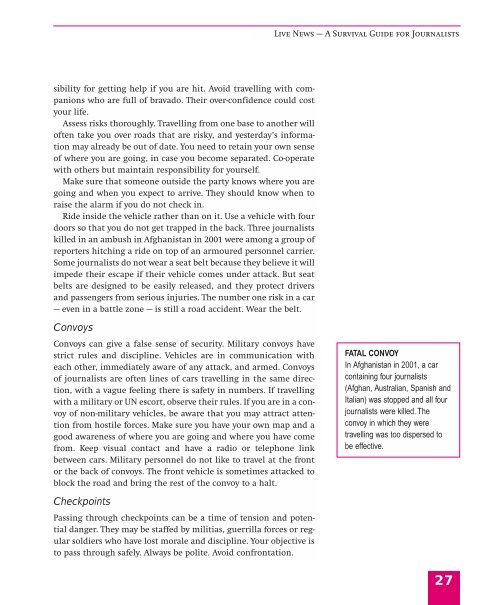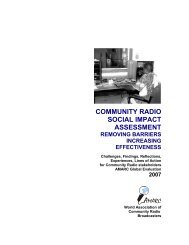Live News - A Survival Guide - International Federation of Journalists
Live News - A Survival Guide - International Federation of Journalists
Live News - A Survival Guide - International Federation of Journalists
- No tags were found...
You also want an ePaper? Increase the reach of your titles
YUMPU automatically turns print PDFs into web optimized ePapers that Google loves.
<strong>Live</strong> <strong>News</strong> — A <strong>Survival</strong> <strong>Guide</strong> for <strong>Journalists</strong>sibility for getting help if you are hit. Avoid travelling with companionswho are full <strong>of</strong> bravado. Their over-confidence could costyour life.Assess risks thoroughly. Travelling from one base to another will<strong>of</strong>ten take you over roads that are risky, and yesterday’s informationmay already be out <strong>of</strong> date. You need to retain your own sense<strong>of</strong> where you are going, in case you become separated. Co-operatewith others but maintain responsibility for yourself.Make sure that someone outside the party knows where you aregoing and when you expect to arrive. They should know when toraise the alarm if you do not check in.Ride inside the vehicle rather than on it. Use a vehicle with fourdoors so that you do not get trapped in the back. Three journalistskilled in an ambush in Afghanistan in 2001 were among a group <strong>of</strong>reporters hitching a ride on top <strong>of</strong> an armoured personnel carrier.Some journalists do not wear a seat belt because they believe it willimpede their escape if their vehicle comes under attack. But seatbelts are designed to be easily released, and they protect driversand passengers from serious injuries. The number one risk in a car— even in a battle zone — is still a road accident. Wear the belt.ConvoysConvoys can give a false sense <strong>of</strong> security. Military convoys havestrict rules and discipline. Vehicles are in communication witheach other, immediately aware <strong>of</strong> any attack, and armed. Convoys<strong>of</strong> journalists are <strong>of</strong>ten lines <strong>of</strong> cars travelling in the same direction,with a vague feeling there is safety in numbers. If travellingwith a military or UN escort, observe their rules. If you are in a convoy<strong>of</strong> non-military vehicles, be aware that you may attract attentionfrom hostile forces. Make sure you have your own map and agood awareness <strong>of</strong> where you are going and where you have comefrom. Keep visual contact and have a radio or telephone linkbetween cars. Military personnel do not like to travel at the frontor the back <strong>of</strong> convoys. The front vehicle is sometimes attacked toblock the road and bring the rest <strong>of</strong> the convoy to a halt.CheckpointsPassing through checkpoints can be a time <strong>of</strong> tension and potentialdanger. They may be staffed by militias, guerrilla forces or regularsoldiers who have lost morale and discipline. Your objective isto pass through safely. Always be polite. Avoid confrontation.FATAL CONVOYIn Afghanistan in 2001, a carcontaining four journalists(Afghan, Australian, Spanish andItalian) was stopped and all fourjournalists were killed. Theconvoy in which they weretravelling was too dispersed tobe effective.27
















